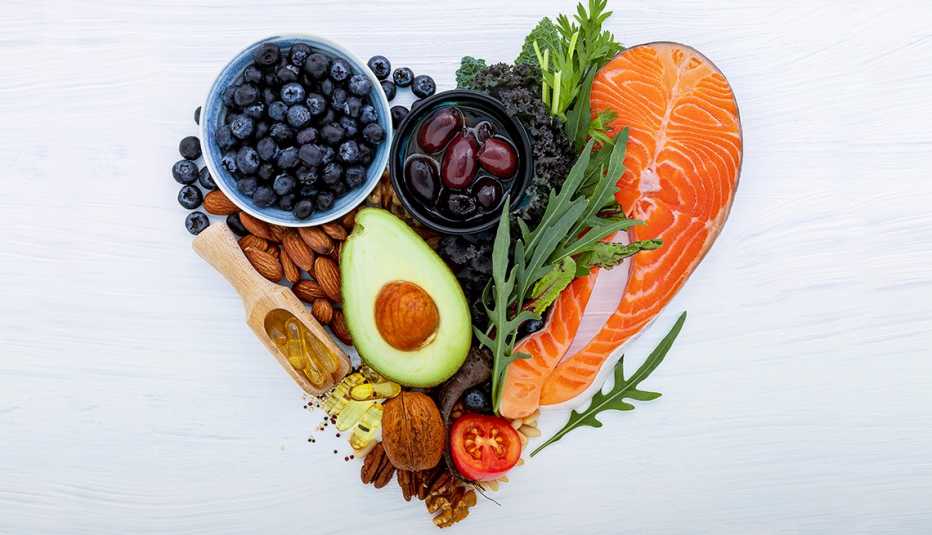Staying Fit


When it comes to what’s best for the health of your heart, don’t walk but run to the DASH (Dietary Approaches to Stop Hypertension) diet.
The dietary plan developed by the National Institutes of Health in 1996 to help people control high blood pressure topped a list of 10 popular diets when it comes to heart health, according to a scientific statement from the American Heart Association (AHA).


AARP Membership— $12 for your first year when you sign up for Automatic Renewal
Get instant access to members-only products and hundreds of discounts, a free second membership, and a subscription to AARP the Magazine.
Other top dietary patterns included the pescatarian-vegetarian-style diet (which is plant-based but includes fish), the ovo-vegetarian-style diet (plant-based but includes eggs) and lacto-vegetarian-style diet (plant-based but includes dairy). The well-known Mediterranean diet also ranked high, followed by vegan and low-fat diets. Adopting a vegan diet can be challenging, but it can be done, particularly if you make the transition in baby steps, some experts suggest. There are also plenty of plant-based alternatives to eggs, beef, chicken and pork including mushrooms, tempeh, seitan, jackfruit and tofu.
AHA Scientific Statement
Published in the journal Circulation, the statement concludes that the DASH diet best aligns with the AHA’s dietary guidance that includes 10 key components to improve cardiometabolic health, which refers to a group of factors that affect metabolism and the risk of heart and vascular disease. The 2021 dietary guidance emphasizes limiting unhealthy fats and reducing the consumption of excess carbohydrates.
9 Key measures of a heart-healthy diet
According to the 2021 AHA dietary guidance:
1. Include an abundance, and wide variety, of fruits and vegetables.
2. Choose mostly whole (not refined) grains.
3. Get protein from plant-based sources such as legumes and nuts; fish and seafood; low-fat or fat-free dairy products. If consuming meat or poultry, choose lean cuts.
4. Use liquid plant oils rather than tropical oils.
5. Minimize intake of beverages and foods with added sugars.
6. Choose and prepare foods with little or no salt.
7. If you do not drink alcohol, don’t start. If you choose to drink alcohol, limit intake.
8. Choose minimally processed foods instead of ultra-processed foods.
9. Adhere to this guidance wherever food is prepared or consumed.
*A 10th factor — “eating to achieve a proper energy balance to maintain a healthy weight” — was not included in the review since this is influenced by factors other than dietary choices.
Source: American Heart Association
“The number of different, popular dietary patterns has proliferated in recent years, and the amount of misinformation about them on social media has reached critical levels,” Christopher D. Gardner, chair of the writing committee for the new scientific statement and a professor at Stanford University School of Medicine, said in a statement.
“The public — and even many health care professionals — may rightfully be confused about heart healthy eating, and they may feel that they don’t have the time or the training to evaluate the different diets. We hope this statement serves as a tool for clinicians and the public to understand which diets promote good cardiometabolic health,” said Gardner, who has focused on investigating the potential health benefits of various dietary components or food patterns for the past 20 years.
The AHA review committee examined the defining features of a broad swath of dietary patterns that are meant to be followed long-term to determine how closely they align with AHA’s guidance, including such recommendations as avoiding refined grains and sugar-sweetened beverages. They found that the 10 dietary patterns varied widely in their alignment with AHA’s guidance, earning scores from 31 to 100.
The Mediterranean diet scored slightly below the DASH diet because it doesn’t explicitly address added salt and includes moderate alcohol consumption rather than avoiding or limiting alcohol. Most of the features of a vegetarian eating pattern align with AHA’s dietary guidance. Pescatarian diets were also in the top tier of heart-healthy diets. AHA recommends fish and seafood as a healthy protein source because most contain omega-3 fatty acids, which are considered a healthy fat and have been linked to heart and brain health.
“If implemented as intended, the top-tier dietary patterns align best with the American Heart Association’s guidance and may be adapted to respect cultural practices, food preferences and budgets to enable people to always eat this way, for the long term,” Gardner said.



































































More From AARP
Can a Pill Help You Quit or Curb Your Drinking?
Medications for alcohol use disorders are just one treatment option
9 Nutrients You Need More of As You Get Older
Find out which vitamins, minerals and other essential elements you may lack in your diet
13 Processed Foods To Eat
Not all bagged, boxed and canned foods are bad